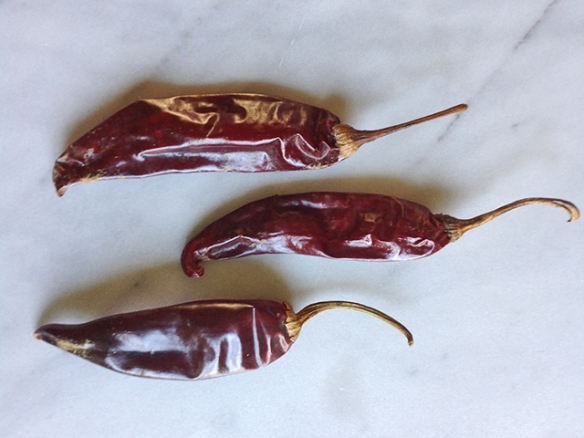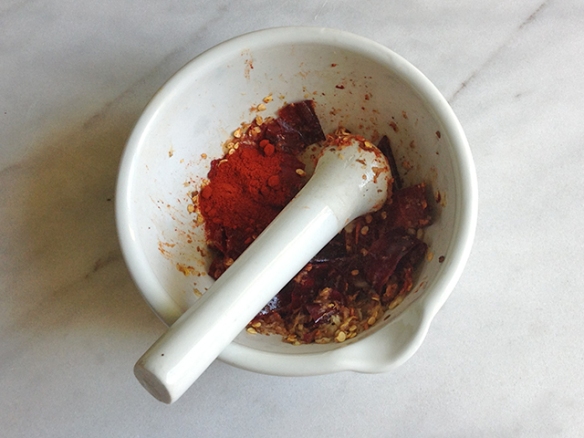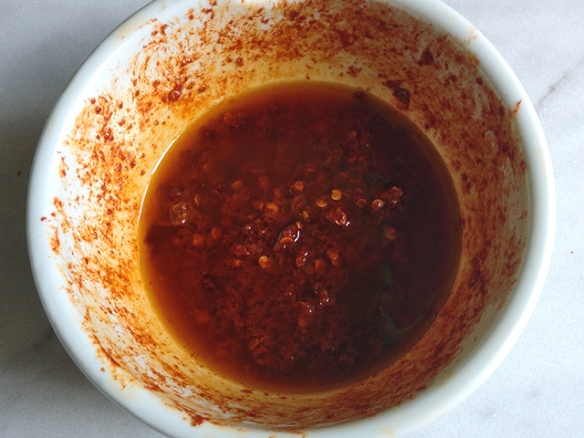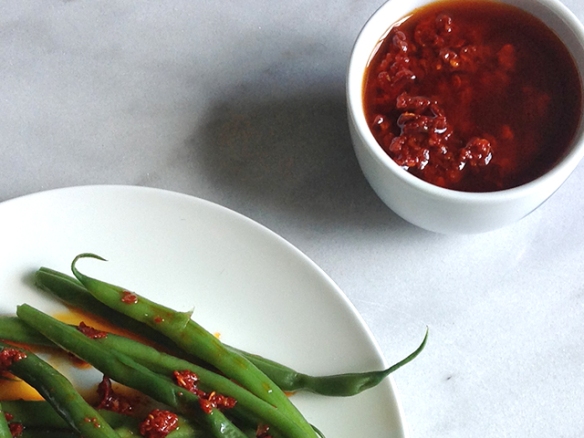You could splash out on a gym membership. Or you could buy a mortar and pestle and bash the living daylights out of a couple of Guajillo chiles for our Mojo Rojo. The difference? The mortar and pestle is a lot cheaper and you end up with a tasty condiment that you can slather on everything (almost). But the biceps, well they’ll be pretty much the same.
Guajillos (pronounced gwah-HEE-yoh) have tough skins. If you’re soaking them (which I recommend) do it for a bit longer than you would say, a New Mexico red. They’re about 4-6 inches long and reddish-brown in color. They’re super popular in Mexico – one of the most commonly grown – and used for soups, stews, adobos, salsas – you name it. But back home, they’re not as well known which is a shame, since the Guajillo is a real culinary workhorse.
A Guajillo has some heat but not tongue-numbingly so. On the Scoville index it sits below the jalapeno. Take out the seeds to reduce the heat or – as I’ve done with the Mojo Rojo – leave them in. Because the skin it tough, it’s hard to end up with a smooth paste but that’s not a bad thing. The Guajillo packs a lot of flavor – beyond mere heat –that you can pick up when your salsa or sauce or rub is chunkier. Mark Miller in his book, The Great Chile Book, describes a Guajillo as having a, “…green tea and stemmy flavor with berry tones.” Sounds good to me.
As always with dried, whole chiles look for ones that are still pliable. You may think that a dried chile should be stiff but that’s not true at all. It should give a bit when you bend it and never smell musty. Give it a sniff and enjoy those lovely warm, fruity aromas.
And a word of advice. If you are using a mortar and pestle, try to alternate between your left and right hands. Otherwise you could end up with the Popeye bicep look. Just a thought…
Mojo Rojo
Makes about ½- ¾ cup (recipe can be doubled)
Yes, you can make this in the small bowl of a food processor or a blender (wimp). But then you’ll miss out on the pure physical pleasure of pounding a Guajillo chile into oblivion. Your choice.
2 Guajillo chiles
6 cloves of garlic, peeled and sliced in half
1 tsp sea salt
1 tsp cumin seeds
1 ½ tsp sweet pimenton (Spanish smoked paprika)
½ cup extra virgin olive oil
2 tsp red wine or sherry vinegar
Heat a frying pan on medium-high heat. Add the whole chiles and toast gently on all sides. The idea is to bring out the flavor of the chiles but do not scorch or burn them. If you do, start over. You can toss the cumin seeds in to – it will bring out the flavor beautifully. Place the toasted chiles in a bowl and cover with hot but not boiling water. Let soak in the water for about 15-20 minutes until pliable.
Meanwhile, place the garlic, sea salt and toasted cumin seeds in the base of a mortar (or use a food processor or blender). Beat with the pestle until a rough paste is formed. Drain the chiles, remove the stem and roughly chop. Add to the mortar and pound until the chile is broken down into small bits. You are not going for a smooth paste – you’ll end up with seeds and chile pieces. Mix in the sweet pimenton, olive oil and vinegar. Season with salt if needed.
Mojo Rojo is great with:
• Green beans or other blanched green vegetables
• Boiled new potatoes
• Butternut squash or sweet potatoes
• Steak, chicken or pork tenderloin
• Spread on bread or as a thick dip for raw veg







I wish I were a cook! Still like reading about it!
This sounds wonderful, and the photos are beautiful! Wouldn’t I LOVE a bite (or a nibble?) of what you’re describing here!!